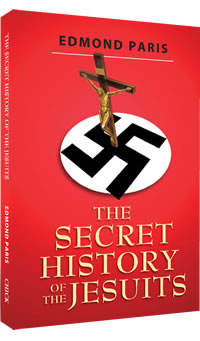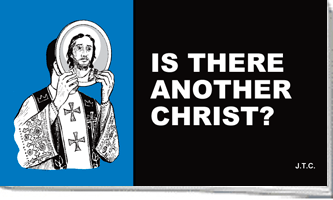Part IV: Rome Equals Vatican

Excerpted from A Woman Rides the Beast
© 1994 by Dave Hunt
Reproduced by permission
"Virtually all attention these days is focused on the coming Antichrist
—but he is only half the story. Many are amazed to discover in
Revelation 17 that there is also another mysterious character at the heart
of prophecy —a woman who rides the beast."
—Dave Hunt
The Bible says the whore of Revelation 17 is a city and gives remarkable clues to her identity. The following is one of a series of excerpts from A Woman Rides The Beast, by Dave Hunt. Here Hunt digs behind these clues which point to only one possibility: Rome and the Vatican. In this book, Hunt's thorough research is a must for anyone who would witness effectively to Roman Catholics.
Some may object that it is Rome, and not that small part of it known as Vatican City, which is built on seven hills, and that the Vatican can hardly be called a "great city." Though both objections are true, the words "Vatican" and "Rome" are universally used interchangeably. Just as one would refer to Washington and mean the government that runs the United States, so one refers to Rome and means the hierarchy that rules the Roman Catholic Church.
Take for example a placard carried by a demonstrator outside the November 15-18, 1993, meeting in Washington D.C. of the National Conference of Catholic Bishops. Protesting any deviation from the pope's wishes, it read: "ROME'S WAY OR THE HIGHWAY." Obviously by "Rome" it meant the Vatican. Such is the common usage. So closely are Catholicism and Rome linked that the Catholic Church is known as the Roman Catholic Church, or simply the Roman Church.
Moreover, for more than a thousand years the Roman Catholic Church exercised both religious and civil control over the entire city of Rome and its surroundings. Pope Innocent III (1198-1216) abolished the secular Roman Senate and placed the administration of Rome directly under his command. The Roman Senate that had governed the city under the Caesars had been known as the Curia Romana (Roman Curia). That name, according to the Pocket Catholic Dictionary, is now the designation of "the whole ensemble of administrative and judicial offices through which the Pope directs the operations of the Catholic Church.
The popes' authority even extended to large territories outside Rome acquired in the eighth century. At that time, with the help of a deliberately fraudulent document manufactured for the popes known as The Donation of Constantine, Pope Stephen III convinced Pepin, king of the Franks and father of Charlemagne, that territories recently taken by the Lombards from the Byzantines actually had been given to the papacy by the Emperor Constantine. Pepin routed the Lombards and handed to the pope the keys to some 20 cities (Ravenna, Ancona, Bologna, Ferrara, Iesi, Gubbio, etc.) and the huge chunk of land joining them along the Adriatic coast.
Dated 30 March 315, The Donation declared that Constantine had given these lands, along with Rome and the Lateran Palace, to the popes in perpetuity. In 1440 this document was proven to be a forgery by Lorenzo Valla, a papal aide, and is so recognized by historians today. Yet allegedly infallible popes continued for centuries to assert that The Donation was genuine and on that basis to justify their pomp, power, and possessions. That fraud is still perpetuated by an inscription in the baptistry of Rome's St. John Lateran, which has never been corrected.
Thus the Papal States were literally stolen by the popes from their rightful owners. The papacy controlled and taxed these territories and derived great wealth from them until 1848. At that time the pope, along with the rulers of most of the other divided territories of Italy, was forced to grant his rebellious subjects a constitution. In September 1860, over his raging protests, Pius IX lost all of the papal states to the new, finally united Kingdom of Italy, which left him, at the time of the First Vatican Council in 1870, still in control of Rome and its surroundings.
The point is that, exactly as John foresaw in his vision, a spiritual entity that claimed a special relationship with Christ and with God became identified with a city that was built on seven hills. That "woman" committed spiritual fornication with earthly rulers and eventually reigned over them. The Roman Catholic Church has been continuously identified with that city. As "The most definitive Catholic encyclopedia since Vatican II" declares:
...hence, one understands the central place of Rome in the life of the Church today and the significance of the title, Roman Catholic Church, the Church that is universal, yet focused upon the ministry of the Bishop of Rome. Since the founding of the Church there by St. Peter, Rome has been the center of all Christendom.
- See more articles on related topics:
- Catholicism
- End Time Prophecy
- Prophecy
Other Articles from May/June 1999:
- APA Sees No Great Harm in Adult-child Sex
- Do you have to believe before you are baptized?
- Religious Freedoms Under Attack
- Missionary Reports 14,000 Responses a Year to Tract Blitz
- Why Many Missions to Muslims Fail
- Pope Worries About Growth of 'Bible Christians'
- Vacationers Get 3-Day 'Jail Ministry' While Witnessing to Indonesian Muslims
- Wicca: Seduction of the Innocents
More on Catholicism:
Products of Interest:
-

Answers To My Catholic Friends
64 pages
A gentle witness you can give Catholics that deals with venerating images, purgatory, where popes go when they die, and more. -

Babylon Religion
224 pages
Learn how a Babylonian goddess became the Virgin Mary. An easy-to-read history of Catholicism's Babylonian origin. -

Secret History of the Jesuits, The
288 pages
Secular historian Edmond Paris reveals Jesuit secrets from the 16th century to World War II: (1) how they quietly gained high ranking positions, giving the Catholic church political dominance, and (2) cunning tactics they used in the past ... and still use today. 
Is There Another Christ?
Have you ever been lied to? Millions have, trusting in "another Christ" to save them. The gospel for Roman Catholics.



